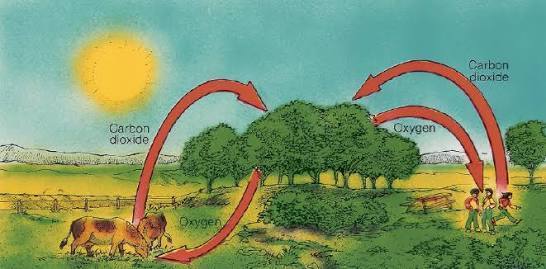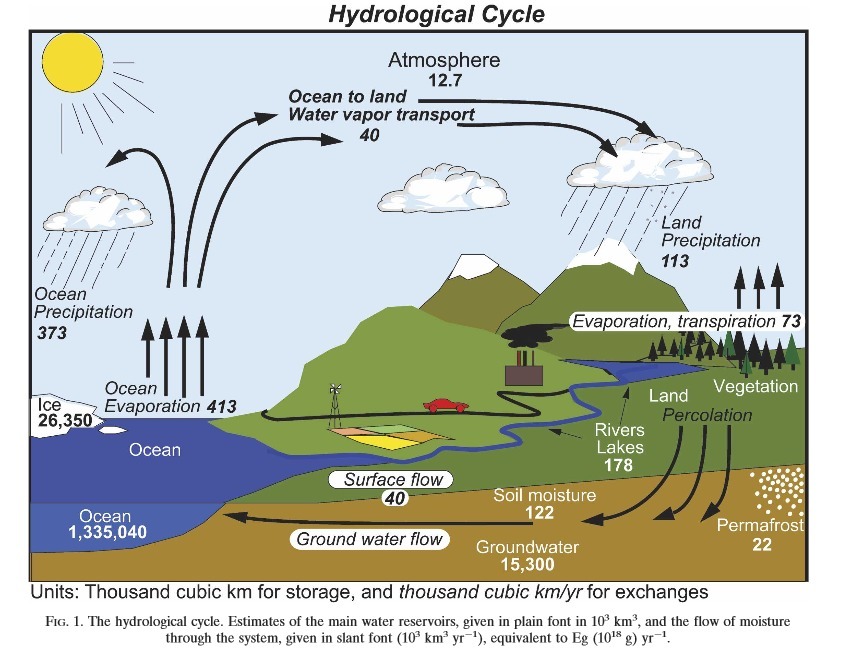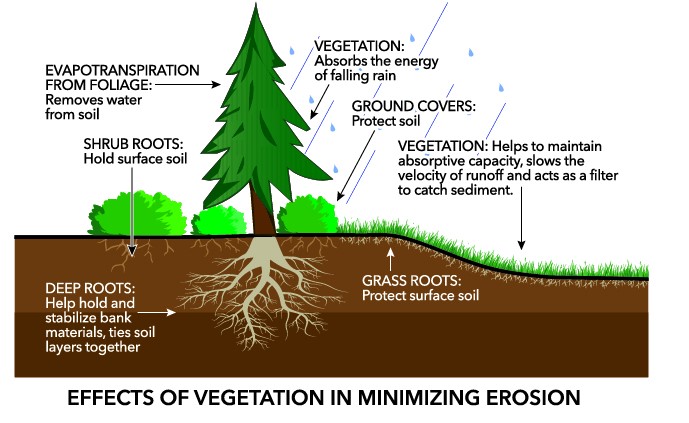Definition and Significance of Forests
Forests are large areas covered predominantly by trees and undergrowth. These vast green expanses are much more than just collections of trees; they are vital for the health of our planet. Forests play a crucial role in supporting life on Earth through their diverse and complex ecosystems.
One of the most significant roles of forests is their contribution to the air we breathe. Trees in forests absorb carbon dioxide, a greenhouse gas, and release oxygen, which is essential for most living organisms. This process helps maintain the balance of gases in the atmosphere, making forests crucial in combating climate change and keeping our air clean.
Additionally, forests influence the climate and weather patterns. They act as natural air conditioners, cooling the environment and contributing to the regulation of temperature and rainfall patterns. This is vital for the stability of our planet’s climate system.
Rapid Revision – Class 7 Science -Chapter 17- Forest our Lifeline – Complete Notes
Role as Natural Habitats and Renewable Resources
Forests serve as natural habitats for an incredible variety of life. They are home to over half of the world’s terrestrial species of animals, plants, and microorganisms. This biodiversity is not just fascinating but also plays an integral role in maintaining the ecological balance. Forests offer shelter, food, and breeding grounds, making them indispensable for the survival of countless species.
Moreover, forests are considered renewable resources. When managed responsibly, they can provide a sustainable supply of resources like wood, fruits, and medicinal plants. These resources are essential for various aspects of human life, from construction and manufacturing to healthcare and nutrition.
Table of Contents
The Structure of a Forest

Forests are not just random gatherings of trees, but are structured in distinct layers, each with its own unique inhabitants and functions. Understanding these layers helps us appreciate the complexity and beauty of forest ecosystems.
Canopy Layer
The canopy is the uppermost layer of a forest, formed by the tops of tall trees. This leafy environment is often considered the primary layer of the forest due to its role in capturing sunlight and protecting the layers below. The canopy is bustling with life, hosting a variety of birds like parrots and eagles, insects such as butterflies and beetles, and mammals like sloths and monkeys. These creatures find food and shelter among the high branches and leaves.
Understorey Layers
Beneath the canopy, the forest is divided into several understory layers:
- Top Layer: This is where younger trees and taller shrubs reside, striving to reach the sunlight. Here, species like woodpeckers and tree frogs can be found, along with climbing plants that use larger trees for support.
- Shrub Layer: Dense with bushes and shorter trees, this layer offers perfect hiding spots and habitat for small animals like rabbits and foxes, as well as a multitude of insects and birds that thrive in the more sheltered environment.
- Herb Layer: Close to the ground, this layer consists of non-woody plants like ferns, grasses, and wildflowers. It’s a crucial zone for insects and ground-dwelling creatures, providing them with food and a place to hide from predators.
- Forest Floor: The base layer of the forest is covered with decomposing leaves, fallen branches, and other organic matter. It is vital for decomposers such as fungi and bacteria, which break down this material and recycle nutrients back into the soil. Small insects, reptiles, and mammals depend on the forest floor for survival.
Each layer of the forest contributes to the overall health and functionality of the ecosystem. From the sun-drenched canopy to the nutrient-rich forest floor, these layers create a complex, interdependent environment where a variety of plants and animals thrive.
The forest floor is not only a layer of fallen leaves and twigs but also a rich source of humus. This dark, organic matter is the end result of the decomposition process and plays a vital role in nourishing the forest.
Also Check – Chapter 12 – Forests: Our Lifeline – 4 Worksheets Solved and Unsolved – Class 7
About Humus and Its Role in Forests
What is Humus?
Humus is a dark, organic material that forms in soil when plant and animal matter decays. It is composed largely of carbon and nitrogen and is essential for the fertility of the forest soil. Humus improves soil structure, making it more porous, which allows for better water retention and air circulation. It also enhances soil fertility by providing essential nutrients to plants.
Significance of Humus in Forest Ecosystems
- Nutrient Supply- Humus serves as a reservoir of nutrients needed by plants, including nitrogen, phosphorus, and sulphur, which are released gradually as plants require them.
- Soil Health- It improves soil health by increasing soil water retention and helping to maintain an even temperature in the soil.
- Supporting Microorganisms- Humus is vital for supporting soil microorganisms, which play a key role in recycling nutrients in the forest ecosystem.
Also Check – What is Humus? Exploring the Heart of Healthy Soil
Exploring the Forest Ecosystem
A forest ecosystem is a complex network of living organisms (plants, animals, and microorganisms) and their physical environment, interacting in a way that sustains life. Let’s break down this ecosystem into its essential components and understand how they work together.
Plants: The Producers
In every forest ecosystem, plants are the primary producers. They use sunlight, water, and carbon dioxide to make their own food through photosynthesis. This process not only feeds the plants but also produces oxygen, which is vital for other organisms. Trees, shrubs, grasses, and other plants form the base of the food chain, providing energy and nutrients to the rest of the ecosystem.
Animals: The Consumers
Animals in the forest are consumers. They rely on plants (and other animals) for food. Consumers are classified into different types based on their diet:
- Herbivores (like deer and rabbits) eat plants.
- Carnivores (like tigers and owls) prey on other animals.
- Omnivores (like bears and raccoons) consume both plants and animals.
These animals play a crucial role in the ecosystem by controlling plant and animal populations, aiding in plant pollination, and dispersing seeds.
Decomposers: The Recyclers
Decomposers like fungi, bacteria, and some insects are vital in breaking down dead plants and animals into simpler substances. This process recycles nutrients back into the soil, which are then used by plants for growth. Decomposers ensure that nothing goes to waste in a forest ecosystem, maintaining the cycle of life.
Scavengers: The Cleanup Crew
Scavengers such as vultures, crows, and certain insects play a significant role by consuming dead animals and plants. They help in cleaning up the forest and preventing the spread of diseases.
Interactions and Support Among Components
In a forest ecosystem, all these components interact and support each other in a balanced way. Plants provide food and oxygen, animals aid in pollination and seed dispersal, decomposers recycle nutrients, and scavengers keep the forest clean. This interdependence creates a stable environment where different species can thrive.
Forests and Environmental Health
Forests are not just collections of trees; they are vital components of our planet’s health. In this section, we will explore how forests contribute to balancing oxygen and carbon dioxide, their role in the water cycle, flood prevention, soil erosion control, and as habitats supporting biodiversity.
Also Check –The Water Cycle: The Steps and Hydrologic Processes from Evaporation to Infiltration
Balancing Oxygen and Carbon Dioxide

Forests play a crucial role in maintaining the balance of oxygen and carbon dioxide in our atmosphere. Trees absorb carbon dioxide, a greenhouse gas, and release oxygen during the process of photosynthesis. This exchange is essential for life on Earth. By reducing carbon dioxide levels, forests help mitigate the effects of climate change, while the oxygen they release is vital for all breathing organisms.
Contribution to the Water Cycle

Forests have a significant impact on the water cycle. Trees absorb water from the ground and release it into the atmosphere through transpiration. This process contributes to the formation of clouds, which eventually leads to rainfall. Forests, therefore, help in maintaining the availability of freshwater, which is crucial for all forms of life, including humans.
Flood Prevention and Soil Erosion Control

Forests are natural barriers against natural disasters like floods and soil erosion. The roots of trees hold the soil together, reducing the risk of landslides and soil being washed away by rain. During heavy rainfall, forests absorb a significant amount of water, slowing its flow and reducing the risk of floods.
Also Check – Soil Erosion: Types, Causes, Effects, and Prevention Explained
Forests as Habitats Supporting Biodiversity

Forests are home to an incredible variety of plants and animals, making them critical areas for biodiversity. They provide shelter, food, and breeding grounds for countless species, including many that are not found anywhere else. The diversity of life within forests plays a crucial role in maintaining ecological balance and the health of our planet.
The Importance of Forest Conservation
In this section, we will explore why it is crucial to conserve forests, the consequences of deforestation, and the methods we can use to protect these vital ecosystems.
Consequences of Deforestation
Deforestation, the cutting down of trees in large numbers, has serious implications for the environment and life on Earth:
- Climate Change: Trees absorb carbon dioxide, a major greenhouse gas. Removing them in large numbers increases carbon dioxide levels in the atmosphere, contributing to global warming and climate change.
- Habitat Loss: Forests are home to a vast array of species. Deforestation leads to the loss of these habitats, threatening the survival of countless plants and animals.
- Increased Floods: Without trees to absorb rainwater, areas become more prone to flooding. Forests act as natural sponges, soaking up water and reducing flood risk.
Methods of Forest Conservation
Protecting forests is essential for maintaining environmental health and biodiversity. Here are some effective conservation methods:
- Recycling: Using recycled products, especially paper, reduces the demand for wood, thereby decreasing the need to cut down trees.
- Afforestation: Planting trees in areas that have been deforested or never had forests is a powerful way to restore ecosystems.
- Sustainable Practices: Sustainable forest management involves careful planning and practices that allow us to use forest resources while ensuring that the forest remains healthy and intact for future generations. This includes selective logging (cutting down only some trees), replanting, and respecting protected areas.
Forest conservation is not just the responsibility of governments and large organisations; everyone can contribute. Simple actions like using recycled products, supporting sustainable forest products, and participating in tree-planting activities can make a significant difference.
Forest Dynamics and Sustainability
In this part of our exploration into forests, we will delve into the dynamic and self-sustaining nature of these ecosystems. Understanding forest dynamics is key to appreciating how these complex habitats maintain their health and continue to grow over time.
The Dynamic Nature of Forests
Forests are not static; they are constantly changing and evolving. This dynamism is driven by the interactions between various components of the forest, including plants, animals, microorganisms, and the physical environment.
- Growth and Regeneration: Trees and plants in the forest grow and age. When old trees die, they create space for new ones to grow, ensuring continuous regeneration. This cycle of growth and decay is natural and essential for the health of the forest.
- Seasonal Changes: Forests experience different phases with the changing seasons, from the budding of new leaves in spring to the shedding of leaves in autumn. These seasonal changes affect the availability of food and shelter for animals, influencing their behaviour and survival strategies.
Interaction of Forest Components
The components of a forest interact in ways that support the health and growth of the ecosystem:
- Pollination and Seed Dispersal: Animals and insects play a crucial role in pollinating plants and dispersing seeds, aiding in the growth of new plants and the expansion of the forest.
- Nutrient Cycling: Decomposers break down dead organic matter, returning nutrients to the soil, which are then used by plants for growth. This cycle of nutrients is vital for sustaining the forest.
- Food Webs: The various food chains in a forest form a complex food web. The balance in this web ensures that no single species dominates, maintaining the diversity and health of the ecosystem.
Forests are self-sustaining systems. Their ability to regenerate and adapt to changes ensures their sustainability over time. The interactions among different components create a balanced environment where each species plays a role in supporting the overall health of the forest.
Ecosystem Services Provided by Forests
Forests provide us with numerous ecosystem services, which are the benefits that humans gain from natural environments. In this section, we’ll explore some key services that forests offer, such as oxygen production, climate regulation, and pollution prevention.
Oxygen Production
One of the most vital services that forests provide is the production of oxygen. Through photosynthesis, trees and plants take in carbon dioxide and release oxygen, which is essential for all living beings to breathe. Forests, therefore, play a critical role in sustaining life on Earth by maintaining the oxygen level in the atmosphere.
Climate Regulation
Forests have a significant impact on the Earth’s climate. They help regulate temperatures and weather patterns in several ways:
- Carbon Storage: Forests store large amounts of carbon in their biomass, which helps in reducing the amount of carbon dioxide, a major greenhouse gas, in the atmosphere.
- Cooling Effect: The process of transpiration in trees (where water is released from leaves) has a cooling effect on the air. This is important in moderating temperatures, especially in urban areas.
- Influence on Rainfall: Forests also affect rainfall patterns. The moisture released by trees contributes to the formation of clouds, which eventually leads to precipitation.
Pollution Prevention
Forests play a key role in preventing pollution. They act as natural filters, absorbing pollutants from the air and water. Trees and plants absorb harmful gases and trap particles of dust and smoke, cleaning the air we breathe. Forest soil and roots filter water, removing impurities and maintaining the quality of our water sources.
Discovering Forest Products and Their Uses
Forests are not only vital for environmental health, but they also provide us with a wide range of products that we use in our everyday lives. Let’s explore some of these forest products and their common uses.
Variety of Products Derived from Forests
- Wood and Timber: One of the most obvious products from forests is wood. It’s used for building homes, making furniture, and creating paper products. Different types of wood like oak, pine, and teak have various uses due to their unique properties.
- Medicinal Plants: Many forests are rich sources of medicinal plants and herbs. These plants have been used for centuries in traditional medicine and are now key ingredients in many modern medicines. For example, the bark of the willow tree is used to produce aspirin.
- Food Products: Forests provide a variety of food products. Nuts like walnuts and almonds, fruits like berries and wild apples, and edible mushrooms are just a few examples. These foods are not only nutritious but also form an important part of the local and global food supply.
- Rubber and Resins: Rubber, used in everything from tires to medical equipment, is obtained from the sap of rubber trees. Similarly, resins from trees are used in making varnishes, adhesives, and fragrances.
- Gums and Spices: Forests are also sources of gums used in food and pharmaceutical products. Additionally, spices like cinnamon and cloves come from the bark and flower buds of trees found in forests.
Everyday Uses of Forest Products
The products we get from forests are used in many aspects of daily life. Wood and timber are fundamental in construction and furniture making. Medicinal plants from forests contribute to healthcare. Foods from forests enrich our diet with natural, healthy options. Rubber and resins are essential in various industries, from automotive to arts. Gums and spices add flavour to our food and are used in various products we consume daily.Impact and Measures of Forest Coverage
Overview of Afforestation and Deforestation
Afforestation and deforestation are two contrasting practices with significant impacts on our environment. Here’s a brief comparison:
- Afforestation: Planting new forests in areas without previous tree cover. It benefits the environment by increasing forest cover, enhancing biodiversity, and aiding in climate regulation.
- Deforestation: The clearing of trees for purposes like agriculture, urban development, or industrial use. This reduces forest cover, impacting biodiversity and contributing to climate change.
Key Differences and Environmental Impact
| Aspect | Afforestation | Deforestation |
| Purpose | Creating new forests | Clearing existing forests |
| Impact on Biodiversity | Enhances ecosystems | Reduces biodiversity |
| Climate Effect | Carbon sequestration | Increases greenhouse gases |
| Soil and Water | Improves soil, aids water cycle | Leads to soil erosion, disrupts water cycle |
For a more detailed understanding of these concepts, read our article: “Afforestation vs. Deforestation – The Key Differences Explained”.
The Importance of Forest Cover
Maintaining and increasing forest cover through afforestation and sustainable practices is crucial for a healthy environment. It supports biodiversity, aids in climate regulation, and contributes to soil and water conservation. Conversely, deforestation poses risks like habitat loss, climate change acceleration, and ecological imbalance. Responsible forest management is key to a sustainable future.
Biodiversity in Forests and Conservation Efforts
In this final section, we delve into the significance of biodiversity in forests and examine the role of biosphere reserves and wildlife conservation projects in protecting this diversity.
The Significance of Biodiversity in Forests
Biodiversity refers to the variety of life forms in a particular habitat or ecosystem. Forests are among the most biodiverse ecosystems on Earth, hosting a wide range of plants, animals, and microorganisms.
- Rich Variety of Life: Forests provide habitat to countless species, including many that are unique to these environments. From towering trees and colourful flowers to diverse species of birds, mammals, insects, and reptiles, forests are teeming with life.
- Ecosystem Balance: This diversity is crucial for the stability and health of forest ecosystems. Each species plays a specific role, whether it’s a predator controlling the population of prey species or a plant providing food and shelter.
- Genetic Diversity: Forests also contribute to genetic diversity, which is essential for species adaptation and resilience to changes, such as climate change or disease outbreaks.
Role of Biosphere Reserves and Wildlife Conservation Projects
To protect this invaluable biodiversity, various conservation efforts are undertaken globally:
- Biosphere Reserves: These are areas designated by UNESCO under the Man and the Biosphere Programme. They aim to conserve biological and cultural diversity while promoting sustainable development. Biosphere reserves include core areas that are strictly protected, buffer zones where limited human activity is allowed, and transition zones where sustainable economic and educational activities are encouraged.
- Wildlife Conservation Projects: These projects focus on protecting endangered species and their habitats. Efforts include creating protected areas, like national parks and wildlife sanctuaries, where human activities are regulated to minimise impact on wildlife. Conservationists also work on specific projects targeting individual species, habitat restoration, and raising public awareness about the importance of wildlife conservation.
Frequently Asked Questions About Forests – Our Lifeline
What is the importance of different layers in a forest?
- Each layer of a forest, from the canopy to the forest floor, supports different types of plants and animals, creating a diverse ecosystem. For example, the canopy provides habitat for birds and monkeys, while the forest floor is crucial for decomposers like fungi and bacteria.
How do forests contribute to the water cycle?
- Forests contribute to the water cycle through transpiration, where trees release water vapour into the air. This moisture contributes to cloud formation and eventually falls as rain, helping to maintain the availability of freshwater.
Why is forest conservation important?
- Forest conservation is important because forests play a vital role in maintaining environmental balance. They provide oxygen, absorb carbon dioxide, support biodiversity, prevent soil erosion, and regulate the climate.
What are the consequences of deforestation?
- Deforestation can lead to climate change, loss of biodiversity, increased greenhouse gases in the atmosphere, soil erosion, and increased risk of floods and droughts.
How do afforestation and deforestation differ?
- Afforestation is the process of planting trees in an area that previously had no forests, which helps increase forest cover and improve environmental health. Deforestation is the clearing of forests, usually for agriculture or urban development, which reduces forest cover and harms the environment.
What are ecosystem services provided by forests?
- Forests provide numerous ecosystem services, including producing oxygen, regulating climate, preventing pollution, and supporting biodiversity.
What kinds of products do we get from forests?
- Forests provide a variety of products like wood, medicinal plants, food items (such as nuts and fruits), rubber, resins, gums, and spices.
Why is biodiversity important in forests?
- Biodiversity is important in forests because it ensures ecosystem stability and resilience. A diverse range of species in a forest means it is better equipped to withstand changes and challenges, such as diseases or climate change.
What is the role of biosphere reserves?
- Biosphere reserves help in conserving biodiversity, cultural diversity, and promoting sustainable development. They include protected areas where wildlife is preserved and areas where sustainable economic and educational activities are supported.
Can individuals contribute to forest conservation?
- Yes, individuals can contribute to forest conservation by using recycled products, supporting sustainable forest products, participating in tree-planting activities, and raising awareness about the importance of forests.
Afforestation vs. Deforestation -The Key Differences Explained
NCERT Solutions for Class 7 Science Chapter 17 Forests Our Lifeline
Chapter 17- Forest our Lifeline – Class 7 Extra questions with Answers
Chapter 17- Forest our Lifeline Class 7 science- Question and Answers Worksheet